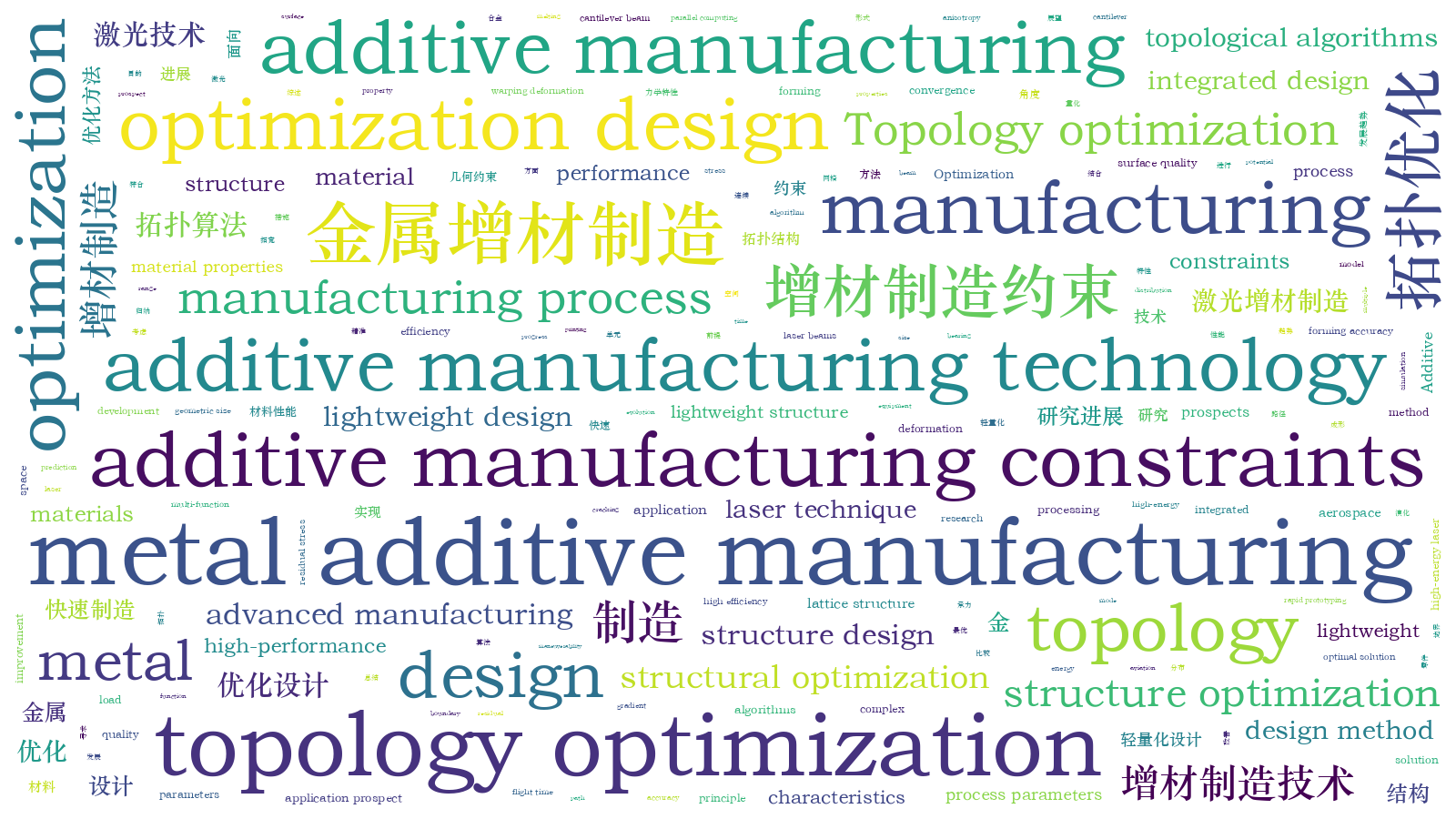面向金属增材制造的拓扑优化设计研究进展  下载: 1179次
下载: 1179次
Owing to the continuous developments in the Chinese aerospace industry, aviation structural parts need to ensure lightweight, high efficiency, long flight time, and high maneuverability characteristics. Therefore, it is a significant challenge in structural optimization design to further reduce the structural quality coefficient. Traditional lightweight designs are mostly based on the replacement of classical structures with equivalent parts, such as lean improvement and excavation of structural potential using the new processes and new materials, and have now approached the “ceiling”.
Topology optimization technology, as an important branch of structural optimization design, determines the optimal material distribution and best load-bearing path by defining material properties, load conditions, and constraints. It is an effective design method for obtaining lightweight structure design and high-performance innovative configurations, and has been widely used in aerospace, automobile manufacturing, and other fields.
However, topology configurations are usually complex. Limited by traditional manufacturing processes, designers often need to simplify the optimal topology configurations, which fails to fully reflect the structural advantages of topology optimization design. Additive manufacturing technology uses high-energy laser beams and adopts the superposition mode of “bottom to up” layer-by-layer material melting, which can realize rapid prototyping and solid-free manufacturing of complex topology configurations without molds. This method addresses the problem of “manufacturing determines design” in structure optimization, which greatly broadens the design space. However, additive metal manufacturing technology is not completely a “free manufacturing” technology, and it is limited by unique manufacturing constraints. Therefore, considering additive manufacturing constraints in topology optimization design, researching and developing topology optimization design for additive metal manufacturing has a broad application prospect.
This study reviews the progress of structural topology optimization design for metal additive manufacturing technology. First, it summarizes the common methods and characteristics of continuum structure topology optimization (Table 1) and compares the cantilever beam topology optimization results obtained with different methods (Fig.1). From the perspective of optimizing topology algorithms, it concludes the effective measures to improve structural continuity and manufacturability based on topology optimization methods of elements and boundary evolution (Figs.2-4). Then, it expounds on the principle, processing characteristics, and application range of the mainstream metal additive manufacturing technology (Fig.5). After that, it summarizes the topology optimization methods considering the geometric size (Fig.8), structural forming (Figs.9 and 10), and material property constraints (Fig.11) of metal additive manufacturing technology (Fig.7 and Table 2). Finally, it prospects the development directions of metal additive manufacturing and topology optimization technology.
In this study, the structural topology optimization of an advanced design technology is integrated with the metal additive manufacturing technology that is an advanced manufacturing technology. This study summarizes the methods, characteristics, and improvement measures of continuum structure topology optimization design. Moreover, it expounds on the principle, characteristics, and application of metal additive manufacturing technology. In addition, it summarizes and prospects the topology optimization methods considering the constraints of metal additive manufacturing, which will provide a reference for researchers to further study the topology optimization design for metal additive manufacturing technology.
Topology optimization design has shortcomings of numerous design variables, weak convergence, and low computational efficiency. It is often difficult for existing topology optimization algorithms to output the optimal structural performance solution that can be directly used in additive manufacturing. Therefore, combined with the parallel computing technology, it is crucial to carry out algorithm research with fewer design variables and better convergence, and output the optimal solution that can be directly used in additive manufacturing.The research on macroscopic topology optimization and microscopic lattice structure is becoming increasingly improved. By effectively integrating the two, fully leveraging the high-performance configurations of topology optimization design and broad design space provided by additive manufacturing technology, the pursuit of high-performance lightweight design has broad development prospects.The topology optimization methods considering the constraints of metal additive manufacturing adopt relatively ideal material models, which differ from the actual printing materials used in metal additive manufacturing technology. Therefore, establishing a precise topological model of material anisotropy under multiple process parameters, quantification of process parameters of metal additive manufacturing equipment, simulation of the metal additive manufacturing process, and prediction of warping deformation and cracking of parts can effectively reduce residual stress and deformation, and improve forming accuracy and surface quality.Topology optimization design for metal additive manufacturing technology is often based on the optimization of a single material. Effectively combining multi-material topology optimization and metal additive manufacturing, studying the topology optimization design and metal additive manufacturing technology of functional gradient materials, and realizing the integrated design of materials, structure, process, and performance, are breakthrough points in the pursuit of high-performance, multi-function, and lightweight.
刘博宇, 王向明, 杨光, 邢本东. 面向金属增材制造的拓扑优化设计研究进展[J]. 中国激光, 2023, 50(12): 1202301. Boyu Liu, Xiangming Wang, Guang Yang, Bendong Xing. Research Progress on Topology Optimization Design for Metal Additive Manufacturing[J]. Chinese Journal of Lasers, 2023, 50(12): 1202301.







